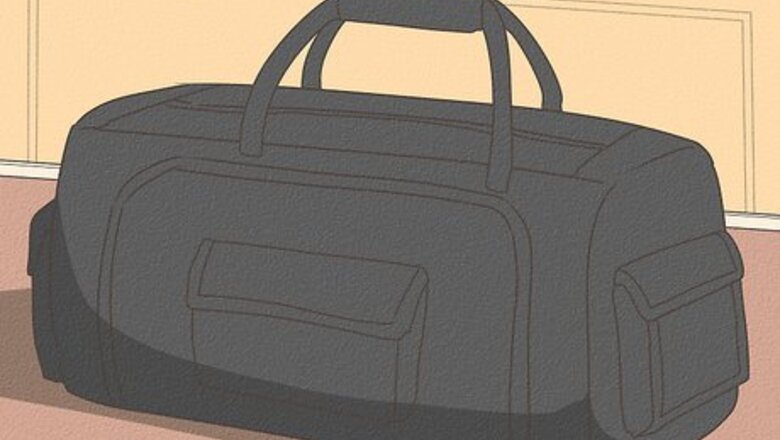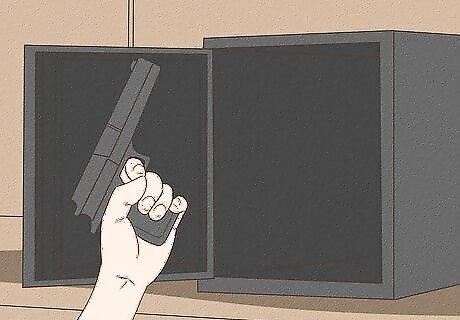
views
X
Trustworthy Source
Cleveland Clinic
Educational website from one of the world's leading hospitals
Go to source
If you have a friend, family member, classmate, or coworker suffering from these symptoms, there are a number of measures you can take to ensure your safety and attempt to help the upset person.
Keeping Yourself Safe

Create an escape plan for emergencies. Hopefully you won't need to get away, but it's better to be safe than sorry. You should have a place in mind that you can escape to if need be, such as a friend's house. Let your friends and family know about the situation ahead of time so that they can quickly come to your aid. Have an emergency bag packed and ready for a quick exit. This bag can include clothes, money, and other personal items. If the situation escalates and you feel like you are in danger, don't be afraid to call the police.

Avoid the situation. If a coworker or someone you are not close to has an IED episode, simply remove yourself from the situation. The person's anger likely has nothing to do with you, and you are not responsible for what he or she is feeling. Unless the person is close to you and you want to try to help, consider simply avoiding the person when he or she is having an episode, or avoiding them altogether if the option is available.

Be aware of dangerous objects. If the person experiences intense rage, they might try to physically harm you. It may be a good idea to remove any sharp or dangerous objects such as firearms from the location if you know in advance that an episode is about to occur. Find a secure place to lock them away until you're sure it's safe, such as a locked room or even an actual safe.

Learn the person's triggers. Some IED episodes may be unpredictable, but if you are close to the person, try to discover what sort of events typically trigger his or her episodes. This could be driving, doing homework, paying bills, or any other event that has the potential to cause upset. Sometimes it may be particular to the person and not something you would expect, so pay attention to the person's behavior and the situation he or she is in right before an episode occurs. Once you're aware of the triggers, you'll be more prepared to either help the person avoid an episode, by directing them away from the triggers or comforting them to prevent a full on attack, or make your own escape from the situation.

Practice using empathic statements. A great way to keep an IED episode from escalating, especially with you as a target of the anger, is to reflect what the person is saying. This will show him or her that you are interested in what they are feeling and that you are not a threat, but that you are trying to understand. If the person expresses frustration at being ignored by a waiter, you can say "So you feel angry that the waiter disrespected you by not giving you his attention?"
Helping Someone With IED

Suggest psychotherapy. IED is not as simple as someone who occasionally gets angry. A person with IED experiences intense anger that seems out of proportion with the triggering event. The person may benefit from professional help. Cognitive-behavioral therapy that includes relaxation training is an effective tool for someone suffering from IED. You can find a mental health treatment center near you by searching on the following website: https://findtreatment.samhsa.gov/locator Cognitive-behavioral therapy involves teaching the person how to restructure their thoughts in order to get a handle on the anger. Relaxation training teaches progressive muscle relaxation, meditation, and other techniques to help the person learn to relax. These techniques can be very effective in managing the explosive anger that comes with IED. If they are resistant to therapy, you can explain that research shows these methods to be effective.

Find positive channels for anger. One of the reasons IED shows up is because people have not found positive ways to experience and channel the anger they feel. Anger is not actually a bad thing unless it builds up without any way to turn it into something positive and constructive. Anger is inevitable and needs to be respected and given a way to express itself. Martial arts, exercise, or even a sport like basketball can help people to channel aggression in ways that are less destructive.

Teach self-calming techniques. If the person is a friend, family member, or someone you are close to, offer to teach him or her techniques for self-calming. Diaphragmatic breathing is a useful technique to start with. Teach the person to breathe deeply into his or her stomach, hold the breath for a few seconds, and then slowly exhale. This type of breathing will decrease heart rate and activate the "rest and digest" part of the nervous system. Progressive muscle relaxation is another good technique, which involves tensing each muscle group in your body and then relaxing them. You can start with the toes and then work your way up to the head. Visualization can help as well. This involves imagining a calm, peaceful scenario, such as laying out at a beach. You should try to fully enter the situation and imagine what the beach is like for all of your senses.

Notify someone. If you aren't close to the person, try to contact a family member or friend that may be able to help him or her out in a crisis situation. You can also do this if you need help calming the person down. Only attempt to help if you are certain of your own safety first.

Move the person to another location. If the person's anger is triggered by a certain event such as traffic, try to remove the person from the location of the triggering event. This can be very helpful in calming his or her nerves and keeping you safe as well. Calmly offer to drive if he or she is experiencing road rage, and then get to a safe location as quickly as possible without breaking any driving laws.

Wait it out. Many IED episodes will not last more than thirty minutes. The person will usually begin to calm down after a while and may experience remorse or embarrassment afterward. If you want to help the person during a crisis and you are certain of your safety, all you may need to do is try to prevent him or her from getting more heated until the episode wears off.
Recognizing Intermittent Explosive Disorder

Look for physical signs. There are several physical indicators of an IED episode you can use to prepare yourself to deal with the situation. If someone you know with IED starts shaking or complains about tingling, chest tightness, or increased energy, these could be signs of an IED episode about to start or having already started.

Be aware of mental symptoms. If the person complains to you about sudden irritability, racing thoughts, or raging emotions, these could also be signs of an IED episode and can be used as an early warning system for dealing with the situation to come. The person may have difficulty verbalizing his or her experience in this way, so you shouldn't always rely on this kind of reporting.

Notice interpersonal symptoms. The person doesn't always need to tell you how they feel; sometimes it comes out in the way they act toward you. If you notice the person starting to shout, throwing a tantrum, engaging in heated arguments, or threatening you, these may be indicators of an IED episode. If threats of violence or actual violence come into play, distance yourself from the person and seek out help.

Understand where IED comes from. The cause of IED is a combination of environmental, genetic, and biological factors. Many people who develop IED grew up in families where explosive behavior was the norm for dealing with conflicts and frustrations. It can be helpful to understand why the person is behaving the way they are in order to take their behavior less personally and see it as a way they have learned to cope with life. Additionally, IED typically shows up in late childhood and may persist for a long time.

Avoid confusing IED with other disorders. There are several other psychological disorders that may look like IED on the surface. Antisocial Personality Disorder, Borderline Personality Disorder, and others can exhibit some of the same symptoms. You may want to talk to a psychologist/psychiatrist for more information if you are unsure if the person has IED.



















Comments
0 comment